

Sullla AGA3: SPGT19a "Cottage Cheese"
v.57
Monarch Difficulty (India - Gandhi)
Note: Gandhi had his original Spiritual / Industrious trait pairing for this game, which he would retain until the Warlords expansion shuffled all the leader traits around.
I played through this complete game and it turned out to be quite an interesting venture. I decided to run the Cottages component, since I hadn't really made much use of cottages in my previous two games and wanted to give them a spin. I'm not the fastest player at the Civilization games; I automate nothing and tend to check my cities constantly to see if I have them set up optimally. (This is why I think I wouldn't make a very good multiplayer candidate  ). In other words, I apologize for getting this in a little late, but hopefully some of the conclusions I have here can still be useful.
). In other words, I apologize for getting this in a little late, but hopefully some of the conclusions I have here can still be useful.
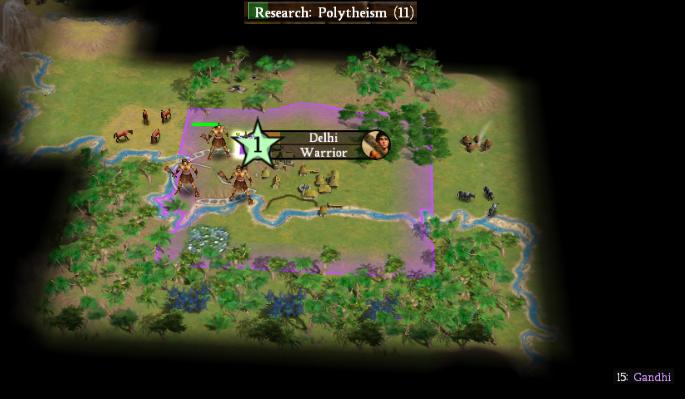
Sirian had already founded Delhi in the savegame file, so my biggest decision was what to research to start. Based on all of the discussion about religion that had been taking place in the general forum, I decided to try the Polytheism -> Monotheism power move and see for myself if it was indeed imbalanced. Therefore I began heading for Hinduism as seen above at a decent rate, and ordered up some warriors for exploration on this map (it was a Large map, after all, so lots to find).
I got a warrior from my first hut; the one right outside my borders was popped with a cultural expansion and yielded gold. Lots and lots of barbs in the jungles around the starting position, it made me glad that I had decided to train some more warriors in the capital. Hinduism was founded in 3450BC, and I also got Judaism in 2880BC. This naturally made Delhi the holy city for both religions, which would prove to be an enormous help down the road. After cleaning up those religions, I swapped into Organized Religion and sent research back into Agriculture (for rice) and Animal Husbandry (for cows/horses). Pursuing the religions delayed my initial expansion, as I didn't want to train a worker before I at least had Agriculture, but I think getting those two religions was a benefit in the long run. My research path certainly seemed like a power move; I need more time to look at the changes in v.58 before coming to any conclusions though.
Initial build order (I believe) was 3 warriors, then a worker, then a settler (not 100% sure on that; I need to take closer notes for the next game). First worker was produced in 2200BC, first settler in 1560BC. I followed the oldest rule in the book for expansion in Civilization, expand towards the other civs first. Even though that land was useless jungle for the moment, once I could cut it all down and set up cottages everywhere, I would rake in the cash. Unfortunately, Washington beat me to the spot I wanted for my first city by 1 turn. 
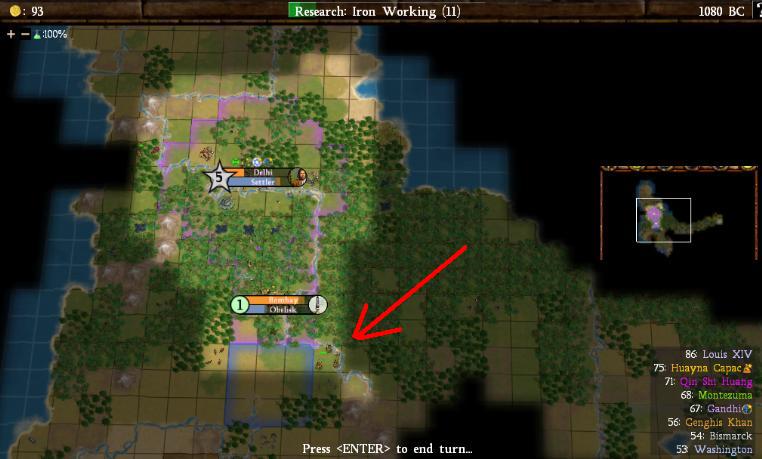
I wanted to put Bombay one tile south of where it is in this picture, but I couldn't because New York (the American city in the picture) got there first. This was not a good omen for my early game, and it was about to get worse. Take a look at the arrow in the above picture; it's pointing to a Mongol archer. On the very next turn, the Mongols declared war and moved into rage to attack Bombay. Uh... I wasn't expecting such ultra-early aggression. It seems like Temujin is pretty violent in Civ4. I had a warrior fortified in Bombay, and the Mongol archer was attacking across a river into the city, setting up a Big Huge Dice Roll (TM) for my early game. In what was basically a coin flip situation, I lost. 
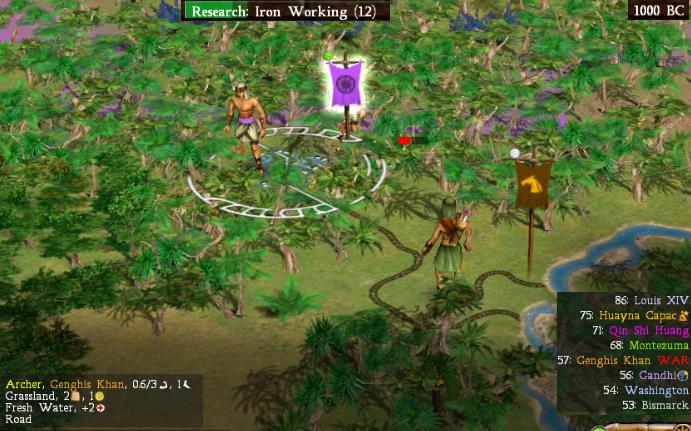
The archer won with 0.6 health left; I wonder if he would have been victorious without his free Combat I promotion? Oh well. My game was off to a wonderful start, but I certainly wasn't about to quit here. Without horses at the start position, I probably would have been eliminated by Temujin early on, but I was able to switch Delhi onto Chariots and take out his offending archer. I fought off the initial attack and got peace, although of course the damage had already been done. No warrior rush in my game!  Anyway, I soldiered on and re-founded Bombay in a spot that overlapped less with New York. I soon got a third city, Madras, in a spot that grabbed the wheat and also had enough non-jungle tiles to actually be useful early on.
Anyway, I soldiered on and re-founded Bombay in a spot that overlapped less with New York. I soon got a third city, Madras, in a spot that grabbed the wheat and also had enough non-jungle tiles to actually be useful early on.
In 250BC, Temujin declared war on Washington (what a nasty customer he is in this game!) and proceeded to get himself involved in another lengthy fight. Seeing that he had just founded a new Mongol city in what was rightly MY territory, and with some chariots used for barb duty in the area, I declared war on Temujin in 175BC and proceeded to wipe the offending city of Turfan from the map:
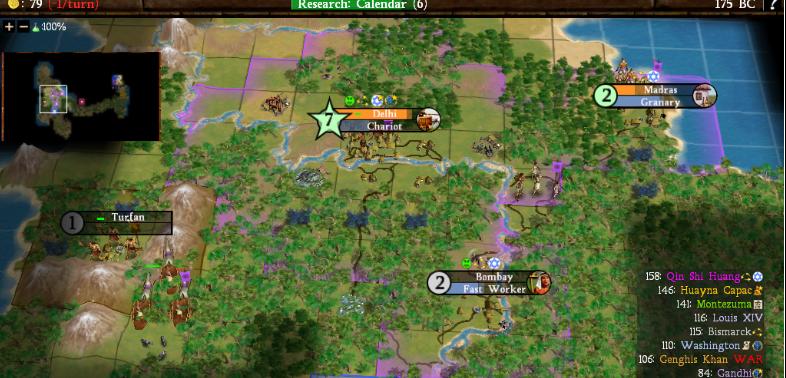
Turfan had 2 warriors, I attacked it with 2 chariots. It would take pretty bad dice luck to lose that battle. Sadly, it was auto-razed at size 1, but I felt I had gained a measure of revenge. Temujin would send more archers at me, and even some swords (!), but I managed to fight them off with chariots and prevent the loss of any cities. I have to believe that the war he also had going with the Americans helped me out there. Got peace in 75AD. In the course of the Mongol/American fighting, New York was also razed, which helped me out a bit. Wasn't expecting that...
A few words on religion are in order. I was expecting to run Hinduism as my state religion in this game. After all, I founded it first and reasonably expected it to be the dominant religion for my civ. But several things conspired to change my plan:
1) Judaism, not Hinduism, spread to all of my starting cities on its own. That was a surprise.
2) I got open borders with Washington and converted him to Hinduism - but in the city of New York, which was then razed by the Mongols before Washington could spread the religion to any other cities. The Americans would end up using a hodgepodge of different religions and kept swapping their state religion around.
3) Judaism spread on its own to Germany, and Bismarck spread it around to his cities.
4) Judaism spread on its own to Mongolia, and Temjuin did the same.
So as a result, I changed my own state religion to Judaism and kept Hinduism around as a secondary religion used only for holy city shrine income. A very strange turn of events, but a good civ player has to adapt on the fly, right? 
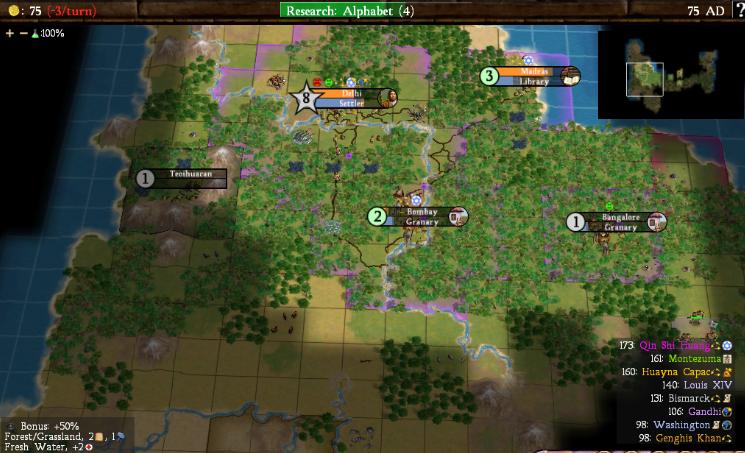
This was my situation in 75AD, shortly before I changed my state religion. I've founded Bangalore in a location where every single tile is jungle. This was not so great for the short run, but I had plans for it down the road, and I wanted to see how strong such a jungle city could be in the endgame. It was all but useless for hundreds of years; I'll return to it later on in this report. A barb city had popped up on the site of the former Turfan, which I would eventually conquer and add into my dotmap. There were so many barb cities around me that I ended up conquering as many cities as I founded. More on barb cities and barbs in general in a minute. After researching the religious techs and then getting the necessary worker ones, I had grabbed Bronze and Iron Working to be able to cut down the jungle. Now I've returned to the top of the tree for Alphabet to enable tech trading, which I would use to catch up on some of the backwards techs I skipped. Overall, I think I made some pretty sound choices early on.
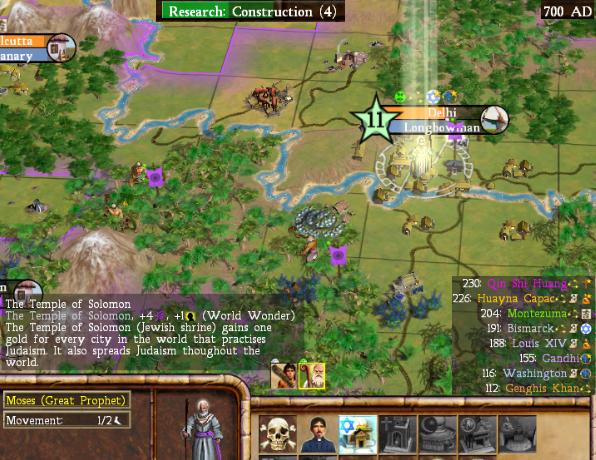
In my previous game, I had failed to get any Great Prophets and thus never was able to build a shrine for my state religion. In order to avoid that, I had Bombay run a priest specialist for about 20 turns to ensure that my first Great Person was a Prophet. Here you see Moses about to build the Jewish Shrine (ha! what a coincidence!); I really like the new light effect for the prophets, by the way. In reading the other reports, I saw that Sirian built the Oracle and used the free Great Person points from it to generate his Prophets. That seems like a strong move I'll have to try down the line. But seeing as how this was only my third game, I wasn't quite aware that such things could be done. 
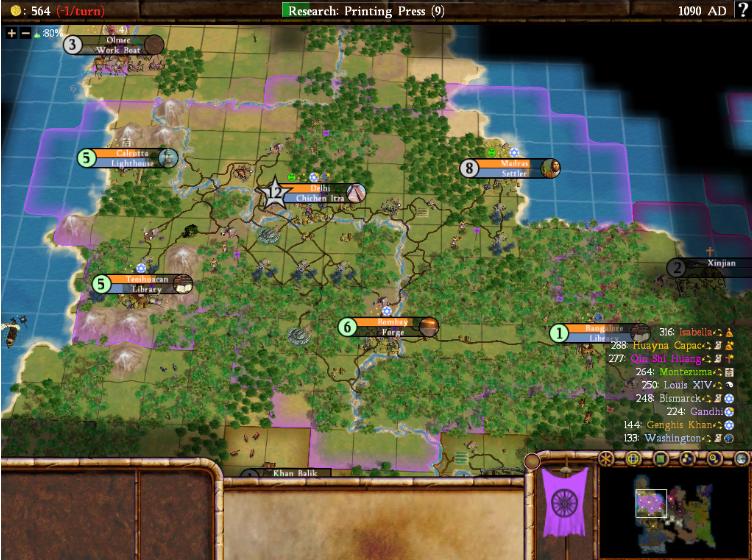
By 1090AD, I had recovered pretty well from my initial struggles. I had founded a couple more cities and my units had been fighting a long engagement with the barbs in the north, taking several of their cities. On this particular turn, I had just discovered Education first and taken Machinery with it, as well as swapping into Bureacracy for the first time. Here, I'm also building Chichen Itza, by far the most important wonder for this game. I would eventually get it in 1210AD:
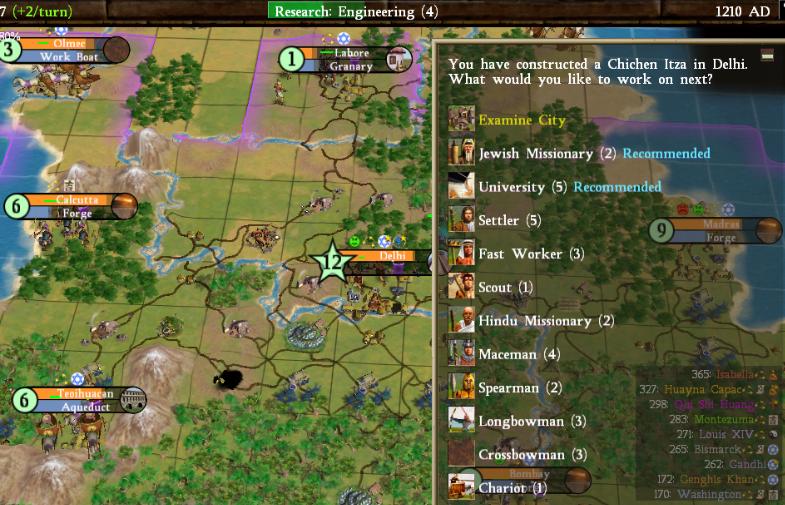
At the time, Chichen Itza discounted all rushed production by 50%. This was extremely powerful, made more so by the fact that cash-rushing unlocked much earlier at Bureaucracy civic / Civil Service tech. The effect was so powerful that it was eventually moved all the way back to the Kremlin wonder in the late Industrial era.
Now a bit about the barbs. I do, in fact, like the much increased prevalence of barbarians in this game. So far, I've managed to avoid losing any cities to them, but their threat means that I can't just leave my cities undefended or send out unescorted settlers, and this is a very good thing in my mind. I would leave the incidence rate of barbarian UNITS completely alone (I don't know what causes them to form, but it seems good). Now the barb cities, on the other hand, are a problem. I don't know what causes barb cities to form, but they are popping up in places that just don't make any logical sense. Here's example #1:
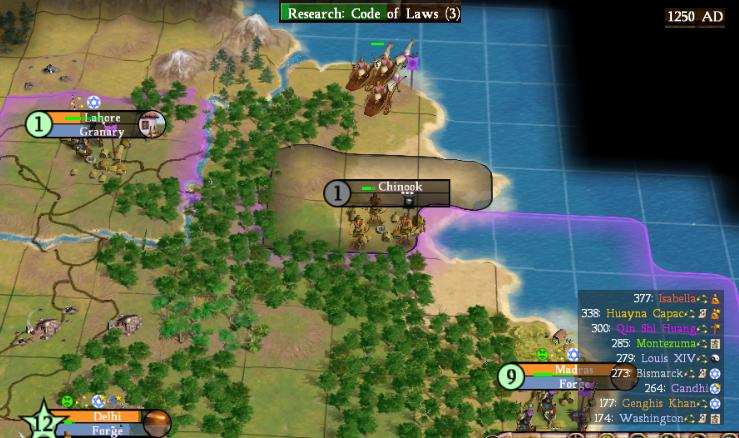
Chinook simply appeared out of nowhere there on my turn. I had my chariot in the area just so that there wouldn't be any fog of war, and yet the city still formed anyway. Now maybe it's just me, but I think it's bad for realism purposes to have barb cities show up literally out of NOTHING and pop out of thin air between turns.  Example #2:
Example #2:
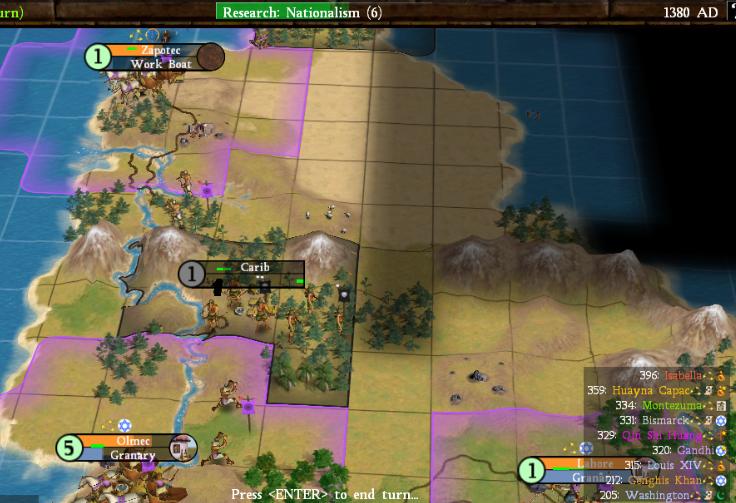
Carib was a huge pain in the rear, sabotaging my efforts to run a road up to Zapotec. Now I can understand barb cities in that fogged area to the right, but they really shouldn't be appearing in areas that I could see. Having to deal with three archers out of nowhere, right on top of one of my cities, was also not cool. The rate at which cities was forming was also ridiculous; I killed off a city and literally two turns later it was back again on the same tile. That's just stupid. This definitely needs to be addressed in some way before release, or otherwise we're going to look silly. But again - keep the random barbarians in place, since they're working just fine.
I was watching where the AI civs were settling cities, and there are still problems with where it chooses to place them. Here's a case in point:
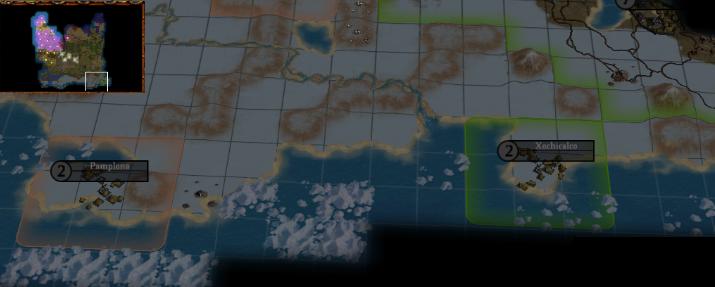
The AI has decided found some cities at the South Pole to look for the "penguin" resource, so it would seem.  There is at least SOME resource by Pamplona, which could perhaps justify this decision, but Xochicalco will never amount to anything other than a cash drain. More work needs to be done in this area still if we're going to avoid the Civ3 "settle everything under the sun" AI mentality.
There is at least SOME resource by Pamplona, which could perhaps justify this decision, but Xochicalco will never amount to anything other than a cash drain. More work needs to be done in this area still if we're going to avoid the Civ3 "settle everything under the sun" AI mentality.
One of the things I focused on in my previous game was the diplomatic AI, and I was taking notes on it again here. The tentative conclusion that I've come to is that the diplo system does, in fact, work but that in v.57 it was being sabotaged by the idiotic demands of the AI civs. Early on in this game, I found that the AI civs were dividing into two camps with regards to their relations to me. There was a group that was willing to sign Open Borders agreements with me and start trading techs and resources (Washington, Bismarck, Huayna Capac). There was also a group that were sourpusses and wanted nothing to do with me (Isabella, Montezuma, Louis, Qin). Temujin was on his own and would having nothing to do with anyone, which seems to be his AI personality in Civ4. Early on, this system was working great and the world was dividing into two trading blocs, which I think is what we want.
Then the demands started. 
As it stands in v.57, the player basically cannot make any friends who have a different religion than their own. This is partly due to the fact that you enjoy a relations boost with civs of the same religion, but more due to the fact that when a civ does NOT share the player's religion, that civ will constantly demand that the player swap religions - sending relations into the toilet. Case in point for this game was Huayna Capac. The Incan leader was my friend all throughout the early turns, and we consistently were trading techs and resources. But over time, since he was Buddhist and I was in Judaism, relations inevitably declined as he demanded I change my religion.
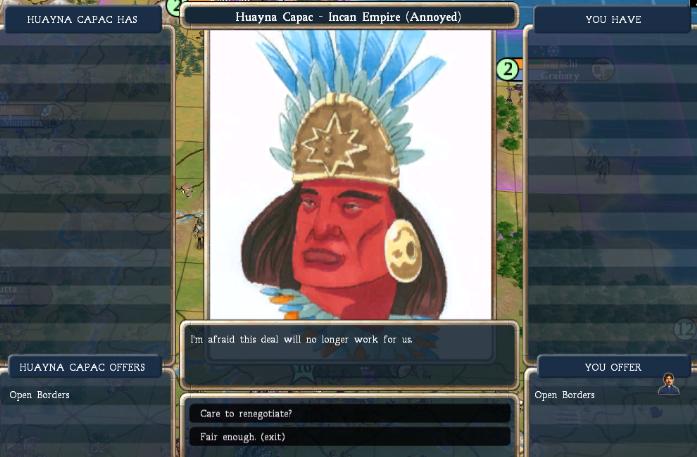
Here you see him canceling our open borders agreement in 1625AD (also note the "settled Great Person" bug that Sirian reported in his game thread). This was purely the result of repeated religious demands; I watched relations drop from Friendly to Pleased to Cautious to Annoyed over the course of multiple demands. And of course there was NOTHING I could do to stop it, other than change religions, which would be idiotically stupid. The inevitable result of these demands to swap religions (and to a lesser extent civics) is this diplomatic screen:
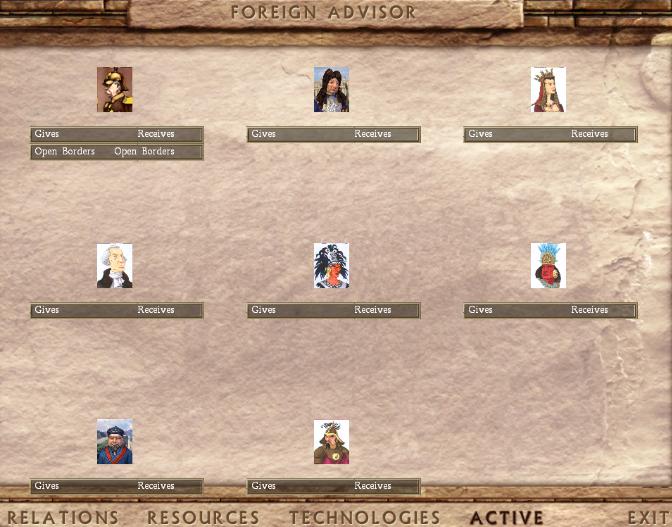
Look at those deals. I can't get trades going with ANYONE! And yet earlier in the game I was trading quite a bit with the other civs in my trading block, so to speak. To be honest, the system would probably work just by scrapping the demands altogether, and that's the single best advice I can give at the moment. Fortunately, according to the v.58 comments this has already been done. I THINK (but don't know for certain) this will yield a better diplomatic system, but obviously I need to test it to find out. That's what SPGT20 is for. 
Anyway, back to the story of what was taking place in my game. In 1585AD I made a triple civics swap from Hereditary Rule -> Universal Suffrage, Slavery -> Emancipation, and Organized Religion -> Theocracy. Once I adopted Emancipation and got the "Freedom Train" rolling, it was only a matter of time before all the other civs dropped into it as well. (Let me say that the new Emancipation would have been enormously helpful in this game! Seems like a much better change.) In 1660AD, Temujin declared war on me out of the blue and proceeded to start moving units into my territory. Since he was threatening my two jungle cities of Bombay and Banglore (each of which was getting less than 10 shields/turn), I used Chichen Itza plus my formidable income to cash-rush a defensive army in the danger zone. This proved to be pretty effective; by 1705AD I had fought off the first wave and survived without any serious threat to my cities. Had one or two tiles pillaged, but that was it. I'll have more to say on the overall strength of the "cottage cheese" strategy at the end of this report.
So I was able to fight off the khan without any real danger, but in 1720AD I got a new foe to deal with as well:
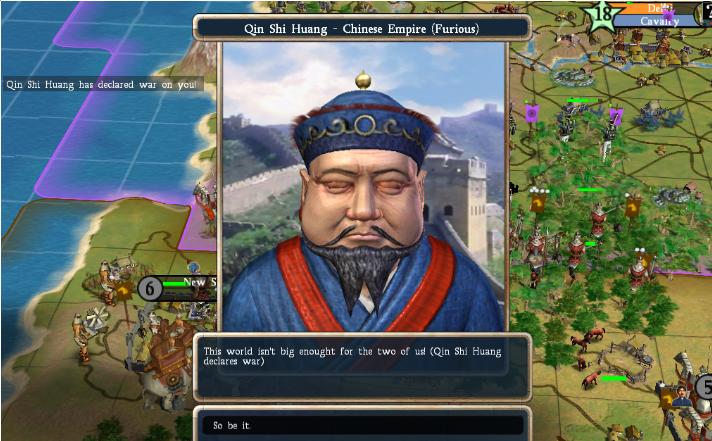
Qin Shi Huang and Kublai Khan somewhat infamously had their leaderhead portraits reversed in the release version of Civ4. This accidental oversight wasn't corrected until the expansions switched them to their intended appearances.
What touched off Qin? Our relations hadn't been good, but I think that Temujin may have actually signed him into the war against me. If so, and it wasn't just a coincidence, it would be a very strong performance from the AI! I reacted to this move by signing peace with Temujin (his cities were just too fortified with units, I wasn't going to be able to advance) and signing Bismarck, my one friend, into opening up a second front in the war against Qin. I don't know quite how helpful this proved to be, but those German units would only take some of the heat off of me.
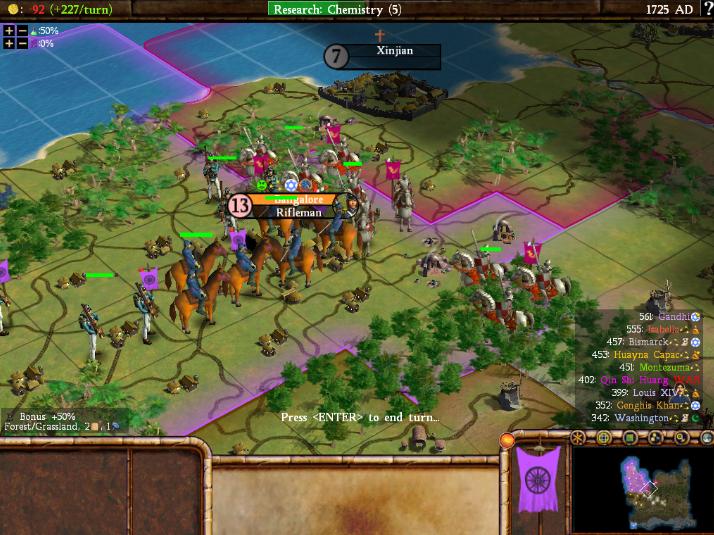
This was the first real war I had ever fought against the AI in Civ4, and it put up a pretty decent fight. The Chinese here had streamed a pretty good number of units into my territory; I had a slight tech edge (I had cavs and Qin didn't), but it was rather touch-and-go for a few turns around Bangalore. My ability to cash-rush an army out of thin air with all my cottages naturally turned the tide within a few turns, but it was tense for a while. (Bureaucracy's ability to go into negative cash is extremely powerful; maybe TOO powerful. The ability to cash-rush is already extremely strong in and of itself. After playing this game, I get the feeling that any Legal civic other than Bureaucracy may turn into variant material. This deserves further investigation.)
The AI seems to be good at producing units when at war. The AI cities were always well-defended and it seems to know enough not to create huge stacks. No more Stack of Doom (SODs) in Civ4. It is very BAD, however, at actually taking cities, and this hopefully can be improved upon. The result I kept seeing was tons of AI units walking around enemy cities, but being unable to capture the durn thing:
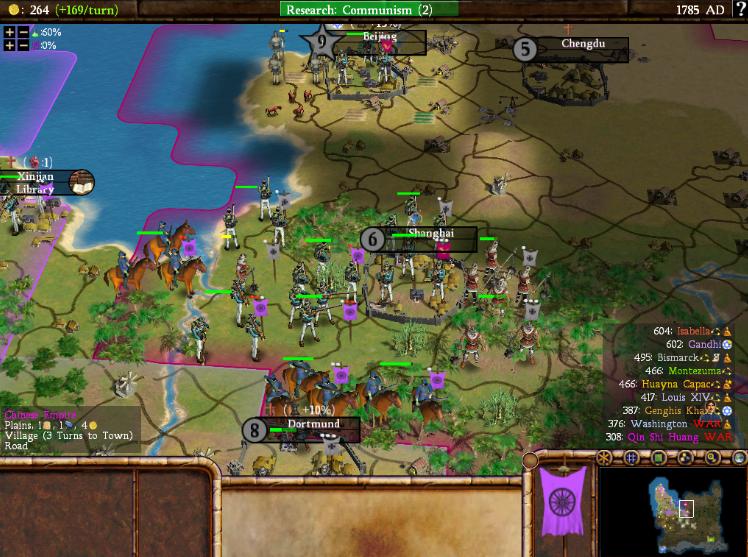
The Germans, for example, had plenty of forces around Shanghai here but never managed to take the city before I got my units in place to grab it. As a result, although the Germans had plenty of units walking around in China, I managed to capture all but one Chinese city. The AI was pretty bad at taking cities in Civ3 as well, but hopefully it can be improved upon before release of this game.
(Side Tangent) - The AI civs are not fighting each other enough. The ONLY AI vs. AI fight that didn't involve me in some way was the super-early fight between Temujin and Washington, and that was probably because Temujin seems to fight EVERYONE in this game. This really needs to be changed before the game is finalized, because otherwise we're moving back into "human versus the world" again, and that is definitely not good. One of the things I liked in Civ3 was that the AI civs would indeed fight each other; they were clearly competing with one another as much as with the human. If we don't have that element in Civ4, it will be a step backwards. As it stands now, the AI civs basically sit and build forever in peace unless the player does something to change that. This needs to be fixed. (End Tangent)
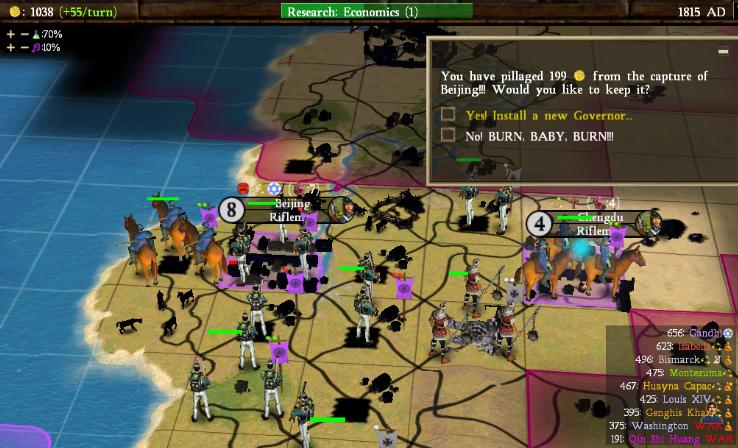
Eventually I ran over Beijing as well, and after that it was just mop-up work. (Not sure what's up with the black graphics in that shot; it fixed itself in a number of turns). The challenge level seemed to be about right; I had to work pretty hard to conquer China, but I had a stronger economy and a tech lead, so it was doable. War weariness also seems to be about right from what I experienced. China finished in 1858AD. The next post will go into the ending details.
Once I finished China, I had reached a winning position and the rest of the game was a foregone conclusion. I considered running over Temujin as well, but I was already running out of time for this game and didn't want to make it even longer. Civ4 also runs insanely slowly on my computer in the later stages (it takes as much as 15 minutes just to load everything), so I didn't want to push it with another war. There are a couple more things I want to highlight in the endgame.
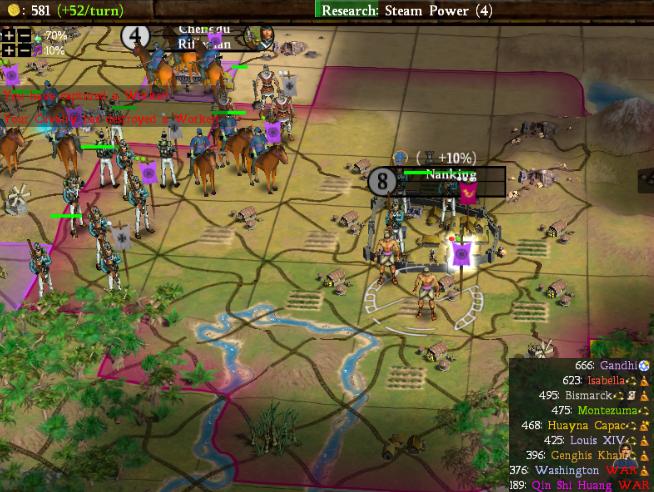
This didn't show up too well once I converted it into a jpeg, but the text in red says "Your Cavalry has destroyed a Worker!" "You have captured a Worker!" When capturing a worker in Civ4, right now the game is playing a battle animation. It's quite weird to see a cav kill off a worker - and then you immediately capture the "dead" unit afterwards!  My cav also got experience for capturing the worker, which I thought was a little odd. At the very least, we need to clear up this bug where it looks like the captured worker is being killed before it gets captured. Going to be some confused people otherwise.
My cav also got experience for capturing the worker, which I thought was a little odd. At the very least, we need to clear up this bug where it looks like the captured worker is being killed before it gets captured. Going to be some confused people otherwise.
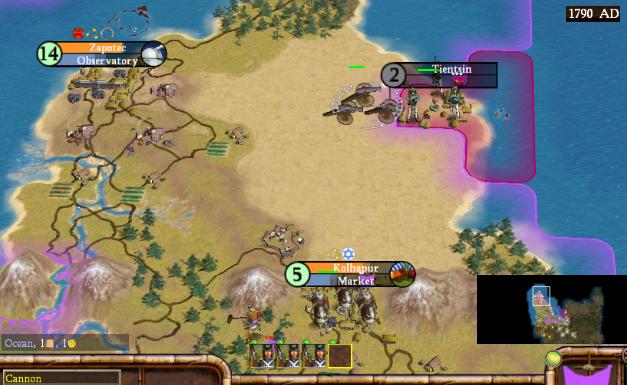
Look where the Chinese put a city before I killed them. And this while we were at war! MAYBE this would be justified if they needed clams, but I still think the AI needs to be programmed not to settle locations like this. And ESPECIALLY not when I'm at war with them! 
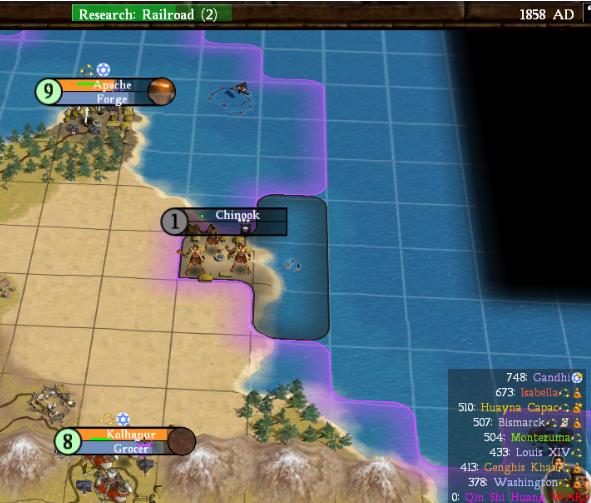
And, since one city on this location wouldn't be enough, the game decided to put a barb city on the tile too!  Yet another reason why barb cities shouldn't be appearing except in the fog of war. I don't think I'll ever see another barb city more hilarious than this one (I certainly hope I don't!)
Yet another reason why barb cities shouldn't be appearing except in the fog of war. I don't think I'll ever see another barb city more hilarious than this one (I certainly hope I don't!)
In any case, after absorbing China I had the most cities and land by a large margin and I began to leave the other AI civs in the dust. My score, which had been in last place after Temujin's early sneak-attack, jumped far out in front by a satisfying margin. Here's where my civ stood in 1900AD:
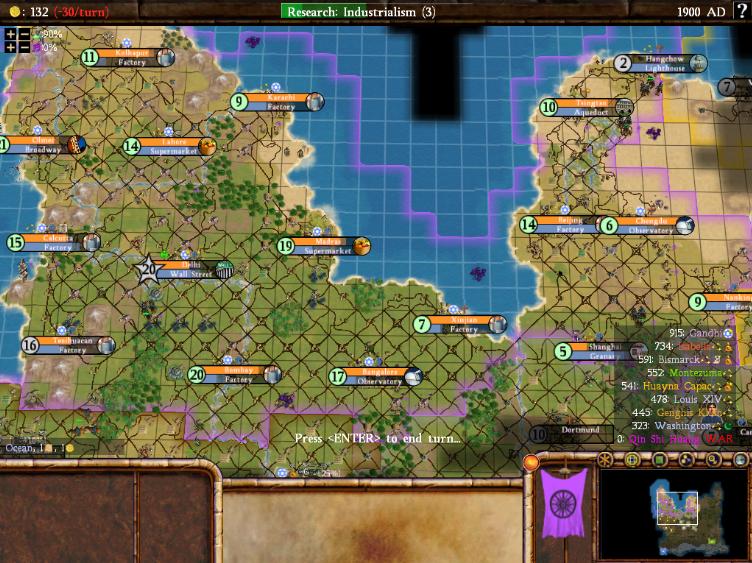
It would be nice if there was some way for the game to recognize when the player has the game won and is on cruise control through the final stages. I have brainstormed some different ways to deal with this, but so far everything I've thought up has been a worse cure than the current disease. If anyone else can come up with some better ways to deal with this problem, I'd love to hear them.
After I researched all of the spaceship techs, I stopped to check what the AI civs had in their possession.
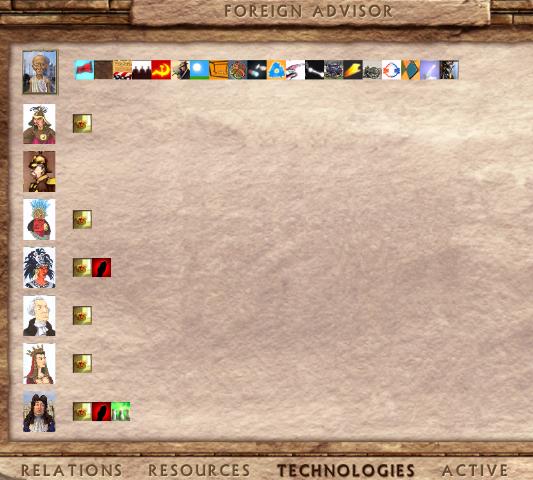
Aside from Divine Right and Fascism, which I had both skipped, the only tech that any civ has up on me is Fission. Louis was badly deficient in other techs; he wasn't close to me at all. Isabella, in second place in score, was roughly 8 techs behind me and no threat whatsoever to launch the spaceship first. This speaks well for the "Cottage Cheese" strategy that I was running in this game. By way of summing it up, I would say that this is certainly a strong strategy, but it doesn't seem (in my limited experience) to be game-breakingly powerful. The biggest problem is that most of the bonuses that get applied to cottages only take place if they have grown all the way to TOWNs, and that takes a very long time. Now, IF the player has enough food to run lots of cottages, and IF he or she has enough time to grow them all into towns, then this can be a very strong strategy indeed. It would be interesting to run this test again using the new Emancipation; I think it would definitely help out this strategy without being too powerful, but again those are only my impressions.
The other big tradeoff on this strategy is that all those cottages result in some cities that tend to be shield-poor. It takes a long time to build anything, and cash-rushing is often the best way to go. Chichen Itza would practically be a must. Theocracy really helps for cities that have the state religion, just because shields are in such a short supply. The other problem is that without lots of farms, there won't be that many great people popping up. I had about six or seven in this game, which certainly isn't a lot. The big, BIG strength is that no one is going to be able to out-research someone who is running all those cottages. Combined with upgrades from all the cash that one is running, it could be militarily powerful. Look what I was able to do with Bangalore at the end of the game:
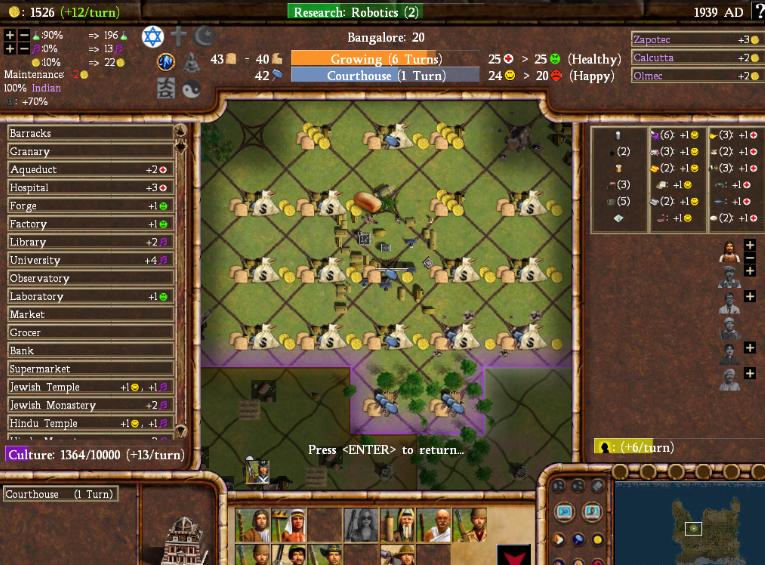
Quick note here that at this point Theocracy had the +25% production bonus for cities following your state religion, which was later moved to the familiar Organized Religion.
I have almost 10 full towns in this former jungle city, and it's pumping out almost 200 beakers/turn. But what I think is even more impressive is that I've managed to get the city to a respectable 42 shields/turn, through the use of two lumber mills, forge/factory, engineer, and theocracy. Getting the extra shield in towns through going to State Property makes a huge difference. A less-extreme city than this with a nicer balance of cottages and farms could be very strong. My overall conclusion therefore is pretty much that the all-cottages strategy seems to be valid, with legitimate strengths and weaknesses, without needing to be balanced in some way. With the new Emanicpation, it should be competitive with the farming/Great Persons route. I wouldn't change too much else here, this area of the gameplay seems solid.
My game ended up crashing in 1942AD when I was within a couple turns of launching. I decided to stop there, since my closest autosave was 4 turns back, and my computer was lumbering along at a very slow pace. I was about to win anyway, so I'm chalking this up as a victory (score was 300 points higher than next-closest civ). Three games now of Civ4: a crushing win on Noble, a squeaker on Monarch, and now a come-from-behind win after surviving early aggression also on Monarch. Yes, I think I'm getting a better handle on this thing now.  Even though there are a number of things that need to be corrected, the game is really looking good and progressing nicely. I have nothing but good impressions of where the project is heading.
Even though there are a number of things that need to be corrected, the game is really looking good and progressing nicely. I have nothing but good impressions of where the project is heading.



